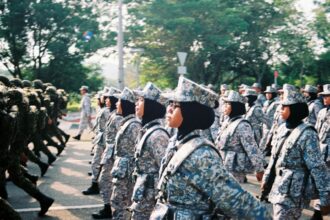The concept of decentralization of lethality in warfare has emerged as a significant paradigm shift in military strategy and operations. Traditionally, lethality in combat was centralized, with command structures dictating the use of force and the deployment of weaponry from a top-down approach. However, the evolution of warfare has seen a gradual move towards decentralization, where individual units and even non-state actors wield considerable power over lethal capabilities.
This transformation is not merely a tactical adjustment; it represents a fundamental change in how conflicts are fought and managed, reflecting broader societal shifts towards autonomy and individual agency. As the nature of conflict evolves, so too does the understanding of lethality. Decentralized lethality allows for more agile responses to threats, enabling smaller units to make real-time decisions based on situational awareness.
This shift has profound implications for military strategy, international relations, and the ethical considerations surrounding the use of force. The following sections will explore the historical context of centralized lethality, the rise of decentralized approaches in modern warfare, and the multifaceted implications of this transformation.
Key Takeaways
- Decentralization of lethality is changing the landscape of warfare, shifting power away from centralized forces to smaller, more agile actors.
- Historical context shows that centralized lethality has long been the dominant model in warfare, with large, organized armies wielding the most power.
- Modern warfare has seen the rise of decentralized lethality, with advancements in technology enabling smaller groups to wield significant power and influence.
- Technology plays a crucial role in decentralizing lethality, providing tools for non-state actors to access and utilize lethal force in new and impactful ways.
- Decentralized lethality has significant implications for military strategy, as traditional tactics and approaches may need to be reevaluated in light of this shift in power dynamics.
Historical Context of Centralized Lethality in Warfare
Historically, warfare has been characterized by centralized command structures that dictated the terms of engagement. From ancient armies led by kings and emperors to modern military organizations with hierarchical chains of command, the concentration of decision-making power has been a hallmark of combat operations. Centralized lethality allowed for coordinated attacks, strategic planning, and the efficient allocation of resources.
This model was particularly effective during large-scale conflicts such as World Wars I and II, where massive armies operated under unified commands.
However, this approach also had its limitations. The rigidity of centralized command often resulted in slow responses to rapidly changing battlefield conditions. As conflicts became more complex and multifaceted, the need for flexibility and adaptability became increasingly apparent.
This historical backdrop sets the stage for understanding the emergence of decentralized lethality as a response to the evolving nature of warfare.
The Rise of Decentralized Lethality in Modern Warfare

The rise of decentralized lethality can be traced back to several key developments in modern warfare. The proliferation of advanced technologies, such as drones and precision-guided munitions, has empowered smaller units and individual soldiers to engage in lethal actions without waiting for higher command approval. This democratization of lethality has transformed the battlefield into a more fluid environment where decisions can be made on the ground, often leading to faster and more effective responses to threats.
Moreover, the rise of asymmetric warfare has further accelerated this trend. Non-state actors, such as insurgent groups and terrorist organizations, have adopted decentralized tactics that allow them to operate independently from traditional military hierarchies. These groups often leverage local knowledge and resources to execute operations that challenge conventional forces.
As a result, state militaries have had to adapt their strategies to counter these decentralized threats, leading to a broader acceptance of decentralized lethality as a viable approach in modern conflict.
Technology’s Role in Decentralizing Lethality
| Metrics | Impact |
|---|---|
| Increased precision | Enhanced targeting capabilities leading to more accurate strikes |
| Reduced human involvement | Automation and AI reducing the need for direct human control |
| Expanded reach | Ability to engage targets from greater distances |
| Enhanced coordination | Improved communication and coordination among decentralized units |
Technology plays a pivotal role in facilitating the decentralization of lethality in contemporary warfare. The advent of communication technologies has enabled real-time information sharing among military units, allowing for rapid decision-making on the battlefield. Soldiers equipped with smartphones or tactical communication devices can relay critical intelligence to their peers, enabling them to act swiftly without waiting for orders from higher-ups.
This immediacy enhances operational effectiveness and allows for a more dynamic response to emerging threats. Additionally, advancements in weaponry have contributed significantly to this decentralization. The availability of portable and precise weapon systems means that individual soldiers can engage targets with lethal force while minimizing collateral damage.
Drones, for instance, have become essential tools for reconnaissance and targeted strikes, allowing operators to conduct missions from remote locations without direct oversight from command structures. This technological empowerment not only increases the lethality of individual units but also raises questions about accountability and control in military operations.
Implications of Decentralized Lethality on Military Strategy
The implications of decentralized lethality on military strategy are profound and far-reaching. As military organizations embrace this shift, they must reconsider traditional doctrines that prioritize centralized command and control. The ability for small units to operate independently necessitates a reevaluation of training protocols, resource allocation, and operational planning.
Commanders must now foster an environment that encourages initiative and adaptability among their troops while ensuring that they remain aligned with broader strategic objectives. Furthermore, decentralized lethality challenges established norms regarding engagement rules and accountability. With individual soldiers empowered to make life-and-death decisions on the ground, the potential for miscalculations or abuses increases.
Military leaders must grapple with how to maintain discipline and adherence to ethical standards while allowing for the flexibility that decentralized operations demand. This balancing act is crucial for maintaining legitimacy in military actions and ensuring that operations align with national and international legal frameworks.
Decentralized Lethality and the Role of Non-State Actors

Non-state actors have become increasingly influential in shaping the landscape of decentralized lethality. Groups such as insurgents, militias, and terrorist organizations often operate outside traditional military hierarchies, relying on decentralized tactics to achieve their objectives. These actors leverage local support and knowledge to execute operations that challenge state forces, often employing guerrilla warfare strategies that emphasize mobility and surprise.
The rise of non-state actors has forced state militaries to adapt their strategies accordingly. As these groups become more adept at utilizing decentralized lethality, conventional forces must develop countermeasures that address the unique challenges posed by such adversaries. This includes enhancing intelligence capabilities, improving inter-agency cooperation, and fostering partnerships with local communities to undermine the support networks that sustain non-state actors.
The interplay between state and non-state forces highlights the complexities of modern warfare and underscores the need for innovative approaches to combat.
Challenges and Risks of Decentralized Lethality
While decentralized lethality offers numerous advantages, it also presents significant challenges and risks that must be carefully navigated. One major concern is the potential for fragmentation within military organizations. As individual units gain more autonomy, there is a risk that they may operate in ways that diverge from established protocols or strategic objectives.
This fragmentation can lead to inconsistencies in operations and undermine overall mission effectiveness. Moreover, the increased reliance on technology raises questions about cybersecurity and vulnerability. As military systems become more interconnected, they also become more susceptible to cyberattacks that could disrupt communications or compromise sensitive information.
Ensuring the integrity and security of these systems is paramount for maintaining operational effectiveness in a decentralized environment. Additionally, there is a growing concern about the ethical implications of autonomous weapons systems that may operate independently without human oversight.
Ethical Considerations of Decentralized Lethality
The ethical considerations surrounding decentralized lethality are complex and multifaceted. Empowering individual soldiers with lethal capabilities raises questions about accountability and moral responsibility in combat situations. When decisions about life and death are made at lower levels within military hierarchies, it becomes challenging to ensure adherence to ethical standards and international humanitarian law.
Furthermore, the potential for civilian casualties increases when lethal actions are taken without comprehensive oversight or coordination with higher command structures. Military leaders must grapple with how to balance operational effectiveness with ethical imperatives that prioritize minimizing harm to non-combatants. Establishing clear guidelines for engagement and ensuring robust training on ethical decision-making are essential steps in addressing these concerns.
International Law and Decentralized Lethality
International law plays a critical role in shaping the discourse around decentralized lethality in warfare. The principles enshrined in treaties such as the Geneva Conventions provide a framework for regulating armed conflict and protecting civilians during hostilities. However, the rise of decentralized lethality poses challenges for enforcing these legal standards.
As non-state actors increasingly engage in armed conflict, questions arise regarding their status under international law and the applicability of legal protections afforded to state actors. The lack of clear accountability mechanisms for decentralized operations complicates efforts to hold individuals or groups responsible for violations of international humanitarian law. Military organizations must navigate these legal complexities while ensuring compliance with established norms to maintain legitimacy in their operations.
Future Trends in Decentralized Lethality
Looking ahead, several trends are likely to shape the future landscape of decentralized lethality in warfare. The continued advancement of technology will play a pivotal role in further decentralizing lethal capabilities. Innovations such as artificial intelligence and machine learning may enable even greater autonomy for weapon systems, raising new ethical dilemmas regarding human oversight and accountability.
Additionally, as geopolitical dynamics shift and new threats emerge, military organizations will need to adapt their strategies to address evolving challenges posed by both state and non-state actors. The integration of decentralized approaches into conventional military doctrine will likely become increasingly common as forces seek to enhance their responsiveness and effectiveness on the battlefield.
The Evolving Landscape of Lethality in Warfare
In conclusion, the decentralization of lethality represents a significant evolution in the landscape of warfare. As military organizations grapple with the implications of this shift, they must navigate a complex interplay of technological advancements, ethical considerations, legal frameworks, and strategic adaptations. The rise of decentralized lethality offers both opportunities for enhanced operational effectiveness and challenges related to accountability and oversight.
As conflicts continue to evolve in complexity and scope, understanding the dynamics of decentralized lethality will be crucial for military leaders, policymakers, and scholars alike. The future of warfare will undoubtedly be shaped by these developments as states seek to balance the need for agility with adherence to ethical standards and international law. Ultimately, the ongoing transformation in how lethality is conceptualized and executed will redefine not only military strategy but also the very nature of conflict itself.
The concept of decentralization of lethality in war is increasingly becoming a focal point in modern military strategies, as it involves distributing the capability to inflict damage across various platforms and units, rather than concentrating it in a few powerful entities. This approach not only enhances flexibility and resilience but also complicates the adversary’s targeting process. A related article that delves into the implications of this strategy can be found on the In The War Room website. For more insights, you can read the article by visiting In The War Room. This resource provides a comprehensive analysis of how decentralization is reshaping military doctrines and the potential challenges it poses.
FAQs
What is the decentralization of lethality in war?
The decentralization of lethality in war refers to the trend of non-state actors, such as terrorist groups and insurgent forces, gaining access to increasingly lethal and advanced weapons and technology. This trend has shifted the balance of power in conflict zones and has made it more difficult for traditional military forces to maintain control.
What are some examples of decentralized lethality in war?
Examples of decentralized lethality in war include the use of improvised explosive devices (IEDs) by insurgent groups, the proliferation of small arms and light weapons among non-state actors, and the use of commercial off-the-shelf drones for reconnaissance and attacks by militant groups.
How does the decentralization of lethality impact traditional military forces?
The decentralization of lethality poses significant challenges for traditional military forces, as it requires them to adapt their tactics, training, and equipment to effectively counter the threat posed by non-state actors with access to advanced weapons and technology. This often involves a shift towards more asymmetric warfare strategies and the development of counter-insurgency capabilities.
What are the implications of decentralized lethality for global security?
The decentralization of lethality in war has significant implications for global security, as it has the potential to destabilize regions and undermine the ability of states to maintain control over their territory. It also raises concerns about the potential for non-state actors to acquire and use weapons of mass destruction, further complicating efforts to prevent and resolve conflicts.




